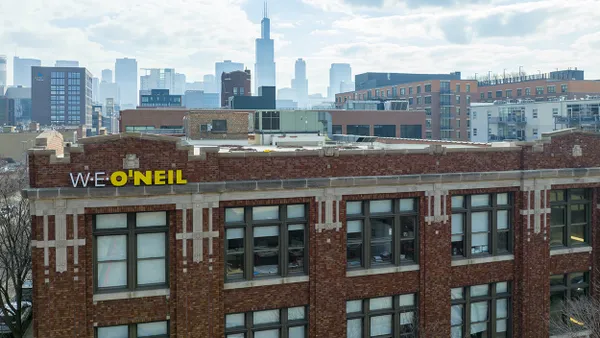A recent one-of-a-kind hotel project in Ocean City, Md., required a first-of-its-kind frame made up of a dovetail long-span composite floor deck system and cold-formed steel (CFS) panelized walls.
The five-story, 78,000-square-foot Aloft Hotel, the chain’s first resort hotel, was completed in just 14 months in May 2019. Iott Architecture and Engineering designed and engineered the hotel, taking a holistic view of building design, the construction timeline, total project costs, and the ways the structural floor design could impact all of these objectives.
The combination of a dovetail long-span composite floor deck system and CFS walls was chosen over post-tensioned concrete, which firm president Keith Iott said is used in approximately 90 percent of the concrete structures built in Ocean City. He estimates that decision cut construction time by 2.5 to 3 months and project costs by $1.5 million to $2.5 million. At the same time, he was able to create open spaces and realize fire-control benefits.
Accelerating construction: The hotel’s lighter-weight dovetail composite floors are supported by a spread concrete footing foundation, eliminating the need for heavy piles and pile caps. This alone cut up to 2 months from construction, Iott said. The thinner, faster-curing composite system also enabled tighter scheduling of the trades that follow in the schedule.
Reducing project costs: The spread-footing foundation supported mammoth savings over a pile foundation. “We saved hundreds of thousands of dollars in piles, in the cost of driving piles, in the cost associated with pile caps, pedestals and everything, and then savings of time,” he said. Reduced floor tonnage also meant fewer and smaller columns on the ground floor, another set of cost savings.
Creating open spaces: The hotel’s open-air style features common spaces uninterrupted by columns and guest rooms with maximum floor-to-ceiling heights. To achieve those objectives, Iott’s design features a steel podium frame on the ground floor while the guest rooms above are made up of load-bearing CFS walls with thin-slab dovetail composite floors, which create the shallowest floor depths possible in multi-story construction. Iott used a 3.5-inch dovetail long-span composite floor deck with a 2-inch lightweight concrete cover. A post-tensioned concrete floor system would have required an 8-inch floor slab, he said. The space savings added 2.5 inches to guest-room ceiling heights.
Controlling fire: Unique to the dovetail composite floor system is a UL-approved head-of-wall design that utilizes staggered deck flutes to create an uninterrupted concrete break that compartmentalizes fire and smoke between the units. The “built-in” breaks eliminate the labor, time and cost of placing expensive—and messy—fire sealants needed if the deck flutes were set aligned over the CFS bearing walls. “Ocean City has a very, very thorough and very responsible fire marshal’s office,” Iott said. “When I showed the fire marshal that head-of-wall detail with the staggered deck flutes, he got it instantly. He said, ‘OK, that’s great. It’s perfect.’ ”
Looking back, Iott said the project might not have even proceeded without the cost and time savings made possible by the dovetail composite floor system and CFS approach.
“The dovetail composite floor deck in the guest room floors was a game-changer in terms of being able to accommodate what we wanted to do structurally, what we wanted to do from a fire-protection standpoint and, more importantly, what we wanted to do in terms of driving the schedule,” Iott said.
More multi-story composite floor options
Composite joist and deck: For projects requiring clear spans up to 60 feet, a composite joist system is ideal. To reach those spans, floor depth must increase. Composite joists use their depth to integrate mechanical, electrical, plumbing (MEP) and other utilities via their open-web design without adding to floor depth. The system can provide a 60-foot open-span with a total floor depth of around 38 inches.
Deep-ribbed composite deck: Deep-ribbed composite floor systems are most often used in projects requiring mid-range open spans up to 36 feet with a shallow structural depth. A project specifying 36-foot open spans, for example, results in a thin-slab floor depth of 13 inches.
__________________________________________________________
For more information about the long-span composite floor systems in this article, visit www.newmill.com/longspan.
Learn more
Credit-hour course: Improving Multi-Story Building Design | .25 LU/HSW Credit
Course description: This short introductory course explains the three types of long-span composite floor systems that represent the trend in long-span, “thin slab” floor design.
Learning objective: Identify the three types of long-span composite floor systems and their distinguishing characteristics.










